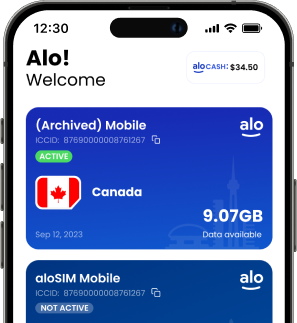Are you planning an overseas adventure travel 2023 trip? Or heading out a little closer to home, without crossing an ocean? Then you’ve likely considered an adventure travel app or two to use on that adventure.
These can be a powerful tool that level up your adventure and help with planning, navigation, tips and tricks, inspiration, connecting with fellow travellers, and safety. And a big part of these apps is powering them with data, even if only for some parts of your trip.
So let’s dive into how staying connected can level up your overseas adventure travel 2023 trips (or those closer to home), and how to best put your data connection to use. (Don’t worry: we’ve got plenty of offline tips here too).
Apps for overseas adventure travel 2023
We weren’t kidding when we said we had some app ideas for you! We’ve rounded up a few suggestions based on adventure travel categories, but we’d love to hear from you too. Which apps do you love using? Send us a DM on Instagram or Twitter.
1. iOverlander (free)
Use it for: Overlanding (exploring land via road tripping, off-roading, and camping)
Data-powered features: Live map viewing, with live Points of Interest (POI). You can add your own, or review or comment on existing POIs
Offline features: Downloaded maps (along with the POIs they feature)
iOverlander was created to help overlanders find their next destination, with geo-tagged “Points of Interest” that help them get there. The first POIs featured were sleeping spots, fueling stations and places to eat, and the list now includes hostels, border crossings, where to find potable water, tourist attractions and even medical and laundry facilities. Many POIs also feature text and photos from users.
Each POI features time-stamped updates to help people evaluate how current the info is. And users can create new POIs, and upload any text and photo context they’d like. Note for offline use: POIs that exist when you download your map are visible offline.
2. AllTrails (free & premium versions available)
Use it for: Access 200,000+ trail maps, navigate trails live and log your trip
Data-powered features: Browse a huge database of trail maps, turn your phone into a GPS tracker, search for directions, watch for signage and record your trip
Offline features: Download maps for offline use, and use device GPS to follow trails
AllTrails is one of the most recognizable adventure apps. This free app’s huge collection of trail maps is one of (maybe the biggest?) out there, giving users access to trail info all over the world, whether on an overseas adventure travel 2023 trip or otherwise.
Its offline capabilities are also worth noting. When using AllTrails maps offline, your phone’s GPS remains enabled, keeping you on the right path. The app recommends that in addition to downloading maps within the app, users should also save maps locally on their devices, in case the device clears its cache (and in-app maps, too).
3. Windy (free & premium versions available)
Use it for: Checking wind (and water) conditions for water sports
Data-powered features: Live weather updates and forecasts, chat with locals and view user updates, hurricane tracker, route planner, upload content
Offline features: Limited. Windy recommends screenshotting any data you need to refer to later offline.
Windy is a great app to use and keep an eye on the weather, particularly from the water. It’s become a go-to for many who want updates on tides, winds, wave swells and currents, making it great for people enjoying any kind of water sport.
It’s also a great app for anyone looking to watch any severe weather during outdoor adventures. This free app (a premium version is available) also features a chat function, allowing users to chat with locals to get their on-the-ground insight.
4. Ramblr (free & premium versions available)
Use it for: Chronicling and sharing geo-tagged content adventure (hiking, biking, skiing, kayaking, road trip, travel, or otherwise)
Data-powered features: Record your trip and add any notes, audio, video or photo media you want. You then upload your content, and share with others
Offline features: Ramblr can record your trip offline, as it uses GPS (other features are limited). Save your trip as a draft, then upload when you’re back online
Ramblr is a geo-tagged adventure journaling app designed specifically for adventure travellers. It allows users to record, chronicle and share their trip, with routes that feature geo-tagged notes, photos, video and audio—whatever you decide to create and share.
Whether you choose to record your altitude, a neat geographical feature you found, trail conditions or other details, you can choose to keep them private, or set them as public to share with other Ramblr users, whose content you can also view. Your shared content becomes your adventure journal, to share or revisit whenever you want. You can also use Ramblr to map out future adventures, too.
Staying connected during adventure travel
Looking to stay connected on your trip while avoiding roaming fees? There are many different options you can choose from, including prepaid eSIM data from aloSIM (hi!).
Whichever option you choose, here is how your data connection can help power your overseas adventure travel 2023 trip (or even adventures closer to home).
Urban exploration
If your outdoor adventure involves exploring well-developed cities and towns, maybe on foot or by bike, you should have no issues with your reception. However, exploring more remote areas can always be tricky.
Do your research, and look up whether other tourists have had reception or connection issues (whether cellular or data) there.
How to use your data for urban exploration: Common data uses for urban exploration include checking Google Maps for walking directions and public transit info, or checking your bookings (tickets, hotels, etc). You can also use your data to read reviews on establishments you’re thinking of visiting, scroll social media or even call an Uber.
Road trips
Prepaid eSIM data is perfect for road trips, powering your Google Maps, playlists and so many other helpful apps to keep you on the right path, and entertained along the way.
The same rule applies here, as stated above: not all geographic areas experience the same level of connection, and you’ll likely drive through a few dead zones. Map out your route in advance, do your research and anticipate these where possible.
How to use your data on road trips: Google Maps is likely the most obvious use case here! You can also use it to stream music, or even movies for passengers. Or, turn your vehicle into a hotspot (we support hotspot/tethering), if passengers want to do some work along the way.
Hiking & cycling
Hikers and cyclists travel many different types of terrain, and often explore remote areas. But many of these areas will have cellular and data reception, if they are in flat terrain, fairly close to developed areas, and are located close to network towers.
Difficult terrain like mountains, for example, is tough for any kind of reception, as the toppography can interfere with network signals. Some areas are simply too rugged for network towers. Get ahead of this by researching the area you intend to explore, and identify any regions where you may not have a signal.
How to use your data for hiking or cycling: Consider using it for one of the adventure travel apps mentioned above, like AllTrails or Ramblr, which have offline features. Do what you can while you have data, then prep offline access for when your signal is temporarily unavailable.
On the water
Sometimes adventure travel is more leisurely, especially when it involves a cruise or even sailing. While open-water boat trips will not have reception, your data will kick in as you get close to shore (or on river cruises that travel in land).
For adventurers enjoying water sports like surfing, using a phone during your activity (even when protected from the water) is risky. If you are kayaking or canoeing, though, you can bring it along with much lower risk. If you do bring it and want to enjoy steady signals, stick close to shore for the best coverage.
How to use your data on the water: When you have data on a boat, use it to monitor weather conditions (consider the Windy app mentioned earlier), or check in on bookings you have when you return to land. For other water sports, such as kayaking/canoeing, surfing or otherwise, consider whether you truly need your phone. Chances are it’s safer on dry land.
Adventure travel without a connection
Like with any adventure, there will likely be moments when you travel off the beaten path. And, if your path is a remote one, that it may not be entirely covered by your data connection (just like how there are pockets of no reception at home, too).
Here’s how to navigate these until you’re back within the area of coverage.
On remote trips, consider satellite devices. Remember when crime show bosses used satellite phones? This technology is the most reliable in remote areas, where standard mobile devices will not stay connected. Although fairly expensive, investing in a satellite communicator (like this one from Garmin) is a surefire communication method in remote areas.
Download content to access offline. Whether it’s serious adventure content like maps or trail info, or entertainment content for road trips like music or movies, downloading your files for offline access is a good thing to keep in mind.
Plan ahead. To get ahead of areas without reception/connection, map out your route and pinpoint trouble areas. Decide where and when you’ll refuel if you’re driving, and where and when to rest if you’re hiking or biking. It’s always good practice to travel with a Personal Locator Beacon (like this one) as well. This will send out a location-specific alert to get help if you’re in distress.
Plan to charge without electricity. Your device is only as good as its battery life, and your connection will drop the moment your battery dies. Avoid dead batteries, even while adventuring, by packing external batteries and solar or wind-up chargers. This will let you charge while on the move, without electricity.
Take care of your device. Adventure travel often means outdoor travel, so consider how this might impact your device. Ensure you can keep it dry in wet conditions, and protected against very hot, or very cold weather (depending on your season of travel).
How to approach overseas adventure travel 2023
There are other factors you may want to consider and plan for when taking off on an adventure trip, to ensure you can fully enjoy your exploring.
Consider setting a voicemail saying when you’ll return from time away, so people don’t worry if they can’t reach you. This is especially important if your route will take you to outside areas of cell tower coverage for a long period of time.
Share itinerary with people and plan check-ins. When you share travel plans and set specific dates to connect with loved ones, they’ll worry less about you on your trip. So focus on your adventure, and check back in at set times to stay in touch, and keep loved ones updated.
Proper gear for each activity. This is important on any trip, but especially important on adventure-centred trips. Consider what footwear, rain and sun gear, bugspray and clothes are appropriate for the adventures you’re about to take on. And always remember to pack some first aid equipment, too. It’s light, and will come in handy for you or someone else.
Be spontaneous, but safe. Your once-in-a-lifetime experience can be fun and thrilling without threatening your safety. Even if you’re an ultimate thrill seeker, do what you can to approach your adventure with safety in mind.
Research each experience, read reviews, read any waiver’s fine print, and ask a ton of questions. No adventure is worth risking your or someone else’s life over.





